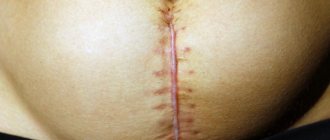General information
The Mirena IUD is considered a highly effective means of preventing unwanted pregnancy. The active ingredient is levonorgestrel, a hormone that is released from the spiral from the first day of installation during the period of use. 20 mcg of the substance is released per day. After 5 years of use, the amount of hormonal content in 1 day is 10 mcg.
Taking into account the physiological norms and characteristics of the female body, manufacturers created a spiral from a core full of hormonal content and a membrane responsible for its gradual release.
Before installing the device, you need to take into account one important rule: the items in the packaging are sterile, therefore, if its integrity is violated, you must refuse to use such a contraceptive. Otherwise, after installing the coil, discharge may appear due to infection and the spread of the inflammatory process.
It is also worth considering that due to the introduction of a hormonal drug, the body needs at least 3 months to get used to its effect. The adaptation period may be accompanied by the appearance of bloody discharge.
Types of spirals
Any intrauterine devices are made from polymers that are safe for the human body. For contraception purposes, a wide variety of products are used, which differ from each other in their shape, dimensional characteristics, and principle of operation. T-shaped tools are considered the most popular, as they are very easy to use and install. At the free end of the Mirena body there is a ring-shaped loop, which is necessary for fixing the thread with which the IUD is removed.
Spirals are distinguished according to their operating principle:
- neutral;
- medicinal;
- hormonal.
The neutral effect is that the introduced object is a foreign body that interferes with embryonic development. Such funds are large and do not provide maximum effectiveness in preventing unwanted pregnancy. They also provoke the appearance of heavy menstruation, accompanied by severe pain. When these IUDs are installed, women very often experience uterine bleeding.
Medicinal IUDs are also divided into several groups depending on the material that was used in the manufacture of the contraceptive. Spirals may contain:
Those products that contain copper are easy to install; they rarely cause any complications, including bleeding. But they have several contraindications in which use should be avoided:
- presence of inflammation;
- diseases of the pelvic organs;
- cervical erosion.
It is worth noting that the danger of erosion when installing a spiral should not be underestimated, since this disease requires mandatory monitoring and treatment.
If a woman has an IUD and there is scanty brown discharge for a long time, it is necessary to consult a doctor to diagnose the development of complications against the background of undetected contraindications to the installation of the product.
Spirals with silver are distinguished by their antiseptic qualities, they fight the inflammatory process, and IUDs, which contain gold, are characterized by the fact that they do not corrode and are fully compatible with the uterine tissues. Such products do not provoke allergic reactions or complications. Gold-containing contraceptives are prescribed for a longer period.
The hormonal principle of action of the spirals is that they contain a hormone that is gradually sent to the uterus in order to provide a contraceptive effect. Such contraceptives are safe and do not cause side effects.
What to do
Copious or prolonged scanty, short-term and massive bleeding requires immediate contact with a gynecologist. Especially if there is an unpleasant odor from the vagina, severe pain in the lower abdomen, and body temperature rises.
To establish the cause of violations, you must:
- undergo a gynecological examination to determine whether the IUD is installed correctly;
- If you suspect the activation of a chronic infection or the addition of a secondary infection, do a microflora analysis.
Depending on what triggered the development of pathological bleeding, the doctor may prescribe anti-inflammatory drugs (Nimesil, Ibuprofen, Naklofen, etc.).
https://youtu.be/fN8OK6blrAY
For bacterial infections, antimicrobial therapy may be necessary. For this purpose, broad-spectrum antibiotics are used. In the future, an analysis should be carried out to determine the sensitivity of microorganisms to the action of antibacterial agents.
In complex treatment, antiseptic drugs (Miramistin, Betadine) and agents for restoring normal microflora (Gynocomfort, Gynoflor, etc.) are used.
Features of installing a spiral
The Mirena spiral is a hormonal system that is easy to install and has a low likelihood of complications. The principle of operation is that it does not allow sperm to penetrate into the upper areas of the woman’s reproductive system and blocks the processes of fertilization of the egg.
Also, after installing Mirena, cervical mucus thickens, which helps block the proliferative layer of the endometrium. This operating principle allows the product to maintain high effectiveness for a long time.
The installation procedure is quite quick, the woman does not experience any discomfort. If there are no contraindications, the gynecologist will schedule a day for the procedure. Basically, the product is installed at the end of menstruation. This takes about 15 minutes. The placement of the IUD in the uterine cavity is painless, as local anesthesia is administered.
However, if there is bloody discharge from the uterus, and it lasts for quite a long time, you need to consult a doctor. This will prevent the development of complications.
Menstruation after the IUD may be scanty, or, conversely, abundant, so we advise you to read a separate article on this topic.
IUD removal algorithm
To remove the IUD, you must visit a doctor at a antenatal clinic or medical clinic on the 3-5th day of your period. The manipulation is carried out step by step:
- the woman lies down on the gynecological chair;
- the vagina is examined in speculums and two-handed examination;
- the doctor reinserts the speculum into the genital tract;
- Using tweezers or special forceps, grab the protruding antennae and lightly pull them.
The coil is easily removed with a small amount of blood or small clots, the process is not painful. After removing the device, the vagina is treated with an antiseptic.
If simply pulling the antennae does not cause the coil to fall out or severe nagging pain appears, its removal is considered complicated. The woman is offered hospitalization. The repeated procedure is performed under anesthesia.
Some people try to remove the IUD from the uterine cavity at home. This may result in the development of vasovagal syndrome, which is manifested by a sharp decrease in pressure, bradycardia and fainting.
Complications and contraindications
The Mirena coil can be installed even in adolescence. But before going for the procedure, it is necessary to exclude the possibility of contraindications:
- neoplasms in the female reproductive system;
- inflammation in the genitourinary system;
- uterine injuries;
- bleeding of unknown etymology;
- cardiovascular pathologies;
- diabetes.
In the absence of these contraindications, the risk of any complications is minimal, but it still remains if errors were made during the procedure.
There are several possible complications that may occur during and after installation of the structure. Sometimes the introduction of an IUD provokes the penetration of pathogenic microorganisms into the body and the development of an inflammatory process. Because of this, you can often observe the appearance of bloody discharge that has a greenish or yellowish tint and an unpleasant aroma.
Also, daubing may appear when the installed structure is rejected. Most often, such complications arise due to improper placement of the spiral.
Trauma or puncture of the uterus causes bleeding. This happens extremely rarely. For the same reason, discharge may appear after the IUD is removed.
Methods and methods for removing an IUD
Most often, IUD removal is performed on an outpatient basis in the middle of the menstrual cycle. The standard IUD removal procedure does not require pain relief. Removal of the IUD is carried out by pulling with a forceps (a special surgical instrument) or tweezers by the antennae, which normally should hang from the cervical canal. This method of removing the intrauterine device is the simplest, safest and least expensive.
If the IUD antennae are missing, the intrauterine contraceptive can be removed instrumentally during hysteroscopy or using an extractor. Instrumental removal of the IUD is carried out under local or intravenous anesthesia. After mechanical expansion of the cervical canal, a hysteroscope is inserted into the uterine cavity. If the intrauterine device lies freely in the uterine cavity, it is grabbed with special forceps and then pulled out. In severe cases, the instrumental method of removing the IUD may be accompanied by damage to the walls of the canal, uterus and bleeding. If the reason for the removal of the intrauterine contraceptive is the presence of inflammatory, infectious or tumor processes in the uterine cavity, after removal of the IUD, smears in the form of fingerprints are taken from it for further histological examination.
Pathological discharge
Regardless of the reason that provoked the appearance of brown secretion after Mirena installation, it is necessary to consult a doctor in order to eliminate the risk of developing possible complications. Such discharge is considered normal only when it does not have any foreign tint, unpleasant odor, or is not accompanied by pain in the lower abdomen or lower back.
Such discharge in the first months after installation of Mirena is caused by disruption of the uterine endometrium. If a woman regularly produces mucus mixed with blood, and also experiences other discomfort, she should urgently visit a doctor to diagnose pathological causes.
Bleeding
Copious bleeding after Mirena installation is a sign of uterine bleeding. This symptom may appear when the introduced contraceptive is rejected. In this case, the blood discharge will not have any specific odor and will acquire a different color, for example greenish or yellowish.
Indications for removal of the intrauterine device
Doctors advise women to install an IUD for a period of no more than 5 years. With modern spirals you can walk for up to 8 or even 15 years. To prevent complications, it is necessary to periodically visit a gynecologist to monitor the position of the spiral.
The indication for removal is the end of the contraceptive's useful life. There are several types of IUDs: copper (duration of use from 3 to 5 years), silver with hormones (suitable for 5 to 7 years), gold (worn for 10 to 15 years in the absence of contraindications).
Other indications for removal: the onset of menopause (a year after the last menstruation, the device is removed from the internal organ due to uselessness), pregnancy (while using a contraceptive in women, in rare cases, ectopic conception of the baby may occur), displacement of the device or its partial loss (removed old and a new one is installed).
The IUD is also removed at the request of the patient if she wants to conceive a child or this method of contraception is not suitable for her. Medical indications for removing the IUD: pain in the lower abdomen, bleeding, the occurrence of an inflammatory process in the uterine cavity and ovaries, the development or growth of tumors and neoplasms.
Contraceptive penetration (ingrowth of the IUD into the muscular wall of the uterus) is a complication that is an indication for removing the IUD. When an IUD is used longer than necessary, it begins to grow into the organ tissue. This can also occur due to improper installation of the contraceptive.
Symptoms indicating the ingrowth of a spiral: deterioration in a woman’s well-being, constant fatigue, internal bleeding, heart rhythm disturbances, dizziness and fainting, pale skin, pain in the lower abdomen.
Treatments
Treatment of discharge that appears after installation of the coil will depend only on the cause of its occurrence. At the same time, only a doctor should diagnose pathologies and complications that arise, and he will also prescribe appropriate therapy.
If the discharge is caused by damage or rupture of the uterus, the means of protection against unwanted pregnancy is removed, and the woman is prescribed anti-inflammatory, healing drugs or surgery. The treatment method is prescribed taking into account the severity of the patient’s condition.
If the discharge is a consequence of an infectious, bacterial or yeast infection of the genitals, drug therapy is prescribed. The earlier the pathology is identified, the easier it is to cure.
If a woman is afraid of the above complications, she should use other methods of contraception. You can give preference to oral contraceptive pills and condoms. Such products do not provoke the appearance of discharge. In the first 3 months of taking OK, brown spotting is allowed.
Installation of an intrauterine device (IUD) is the most effective method of contraception, but also the most effective one that is used today in gynecological practice (except for tubal ligation - sterilization). When an IUD is inserted, the integrity of the mucous membranes of the cervical canal is disrupted, which causes bleeding. We’ll talk about how long the discharge normally should be after installing the IUD and what nature it should be.
As a rule, the installation of an IUD occurs on the 3-4th day of the cycle, when a woman is still menstruating. This is due to the fact that during this period the cervical canal, where the spiral is actually inserted, has a reduced tone and is slightly expanded, which ensures the normal removal of menstrual blood from the uterine cavity. And when the cervix is expanded, the procedure for installing the IUD becomes easier and less painful for the patient.
Can a violation be a variant of the norm?
When using intrauterine contraceptives, complications occur extremely rarely. Despite the fact that all consequences are preventable, a woman should know how they manifest themselves and, if necessary, seek medical help:
- Bloody discharge after installation of the IUD is observed in 15% of women. They may appear periodically during the first year of using the contraceptive.
- Expulsion of the IUD. Rejection is manifested by pain in the lower abdomen, bleeding between menstruation, discharge after sexual intercourse, and the sensation of an IUD in the vagina.
- Pregnancy with an IUD. It occurs very rarely and is usually caused by undiagnosed expulsion. In this case, the IUD should be removed as quickly as possible.
- Perforation of the uterus or cervix. The frequency of complications depends on the form of the contraceptive, the anatomical structure of the uterus, and the qualifications of the doctor. It is characterized by severe pain when inserting the coil, disappearance of the threads, and bleeding.
- Infectious processes of the pelvic organs. Complications occur in women who have multiple sexual partners. Symptoms of sexually transmitted infections include discharge with an unpleasant odor, high body temperature, and nausea.
Sometimes, when installing an IUD, an infection can occur.
Most women bleed after installing the IUD; this is not always a pathology. The contraceptive is administered from the 3rd to the 8th day of the menstrual cycle. During this period, small menstrual flow is still present, and due to mechanical stress, it may intensify. During the process of implantation of a foreign body, small amounts of blood often appear between menstrual cycles.
What discharge is considered normal during an IUD?
Discharge after placement of the IUD is a common occurrence that causes concern for those who use it for the first time. There is no need to worry, because in most cases this is the norm. Experts say that such symptoms after the installation of an intrauterine device are a common side effect, which most likely means a normal reaction of the body rather than a pathological one.
Basically, this is a brown discharge that can begin a few days after the installation of the IUD, and it can last from several days to several months.
It is worth considering that this device is inserted shortly before the end of the menstrual period, therefore, spotting after installation may be the planned end of menstruation. This may be copious discharge of bloody mucus or minor spotting. It is also normal for such manifestations to occur between periods.
After insertion of the IUD, discharge may also occur due to the fact that small vessels of the endometrium (internal tissue of the uterus) were affected. Such bleeding is insignificant, but may be accompanied by nagging pain.
Brown discharge with a spiral may be a natural reaction of the body to a foreign object. This phenomenon can drag on for even six months. It is also not a violation of the change in the nature of menstruation: bleeding may become much stronger, or vice versa, the amount of blood will decrease.
After installing Mirena, the body may react to externally administered hormones with brown discharge. After a while, the hormonal balance will resume, and these phenomena will disappear.
If the bleeding does not go away for a long time, and the pain does not leave you, you should consult a doctor, because this is already a deviation from the norm.
Cause of bleeding during IUD installation
Bleeding after the procedure is very common. For what reason does blood flow?
Light spotting bleeding does not pose any danger; it occurs in every woman. The situation is considered normal, even if it lasts up to six months. Over time, the discharge should become less and less. If blood is released in large quantities and for a long time, only a doctor can help.
Light bleeding after IUD placement decreases by the eighth cycle. Menstruation with the IUD should be the same as before. To exclude the occurrence of infectious diseases, the doctor prescribes anti-inflammatory drugs. Inflammation may occur due to individual intolerance to the contraceptive substance.
If there is heavy bleeding from the IUD, the doctor prescribes an examination for the woman. Identified diseases require treatment. If nothing dangerous is detected, and blood continues to be released in large quantities, the doctor removes the IUD.
Leaving the IUD in place during severe blood loss is dangerous for a woman’s health; it leads to severe anemia. To prevent a decrease in hemoglobin, the doctor prescribes iron supplements and an iron-rich diet to the patient.
Bleeding after removal of the coil is not uncommon. It occurs as a reaction of the body to the withdrawal of hormonal medication. The body needs time to rebuild and restore its monthly cycle.
Complications occur more often when using copper coils. Hormonal IUDs are less likely to cause negative consequences.
Doctors say that the IUD is not indicated for every woman. Each organism is individual and does not always adapt to the spiral or the material of its manufacture. In rare cases, contraceptive rejection occurs. In such situations, a woman needs to choose other means of birth control.
https://youtu.be/WnN2Gr0-Eaw
Pathological discharge when using a spiral
Infection
This contraceptive is designed to protect a woman from unwanted pregnancy, but it does not perform a barrier function against various infections, viruses and fungi. Moreover, it is a kind of conductor for them and in some situations may even be the root cause of inflammation of the pelvic organs. This may be indicated by excessive bleeding with discomfort, or the presence of an unpleasant odor or greenish or yellowish mucus color.
Fixture offset
One of the complications that can cause bleeding during the installation of the coil is its loss or displacement. This includes both spontaneous violation of the position and rejection by the body. A foreign body is a fairly large load on a well-functioning reproductive system, so it can take this device for too long, letting bloody smears know about it, or not take it at all.
To avoid displacement of this remedy, it is not recommended to lift heavy objects, apply pressure, or have sex in the first 2 weeks after implantation. It is recommended to regularly check that the coil is in place to prevent movement. This can lead to injury to the genitourinary system, as well as unwanted pregnancy.
In 0.02% of cases of installation of this contraceptive, bleeding may be caused by damage to or puncture of the uterus. This occurs due to improper insertion or placement of the device. The phenomenon is very rare, but it does happen. In this situation, the main thing is to consult a doctor in time to avoid inflammatory processes and pathological injury.
Ectopic pregnancy
Since no contraceptive means can guarantee a 100% result, conception may still occur with the IUD. But if this happens, it will most likely be in the form of an ectopic pregnancy. A sure sign of this is brown and bloody discharge with increasing and prolonged pain. Follow the link to see what discharge may appear during an ectopic pregnancy.
The spiral has “tendrils” that expand the walls of the uterus. In rare cases, this may be indicated by an increased amount of blood released during menstruation.
Whatever the reason, you need to contact a specialist to determine the cause of the discharge. It is worth remembering that the problem does not go away on its own, and large blood loss can lead to anemia and other serious consequences.
Reviews from women and specialists
Feedback from patients and specialists allows us to conclude that the intrauterine device is a highly effective means of contraception, which has been used abroad and in domestic practice for decades.
In recent years, the IUD has become affordable. It is easy to install, the procedure itself takes no more than 15 minutes. The process is painless if there are no contraindications, and it is carried out by an experienced specialist.
An additional advantage is that installation of this product is possible at any age. Some women in their reviews say that they had the IUD for almost the entire period of their reproductive years.
A natural occurrence when placing the IUD inside the uterus is discharge. As a rule, they are brown and have no foreign odor. Depending on the cause, such bleeding lasts from several days to six months.
Victoria, 42 years old: “As long as I have been sexually active (since I was 17 years old), I have been wearing the IUD for as long. All my life she protected me from conception. When my husband and I decided to have a child, as planned, the specialist removed it, and after two menstrual cycles I was able to get pregnant. After giving birth, this wonderful invention was placed again. I didn’t notice any special discharge; as a rule, it was a slight spotting for about a week, and in the first days after the installation I felt a slight tug in my lower abdomen.”
Marina, 25 years old: “After the implantation of the IUD, my period lasted for another two weeks. As it turned out later, it was discharge against the background of endometrial detachment, the vessels of which are quite weak. This is how the specialist explained it to me. Now my menstruation is going differently. There's a lot more blood. But it doesn't make me uncomfortable. The main thing is that I am reliably protected from an unwanted pregnancy.”
Thus, the IUD is an excellent, highly effective contraceptive. When placed correctly and all rules of use are followed, it gives the highest results among means of protection and does not cause harm to the body. IUDs were invented for those women who keep up with the times and value their health.











